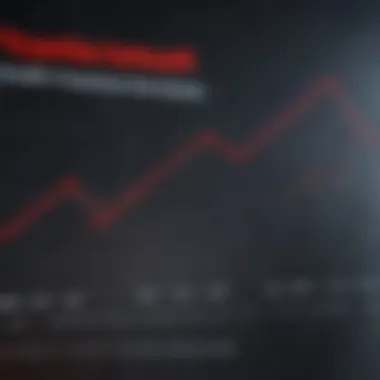Exploring Bank of America Account Rates and Fees


Intro
When it comes to managing finances, the choices one faces can seem overwhelming, especially with a large institution like Bank of America. From checking accounts to various types of savings and investment products, there’s a vast landscape to navigate. Understanding the account rates is not just a matter of curiosity; it’s a pivotal aspect of making informed financial decisions. This article will break down the intricacies of these rates, shedding light on the products available and the implications of their respective features.
In the world of banking, it’s all about maximizing returns while minimizing costs. A clear grasp of the account rates offered by Bank of America can empower both novices and seasoned investors alike. Being armed with the right knowledge means less chance of falling into traps that hide fees or underperforming accounts.
Without further ado, let’s dive into the nitty-gritty of account rates, beginning with an overview of the investment products on offer.
Understanding Bank of America’s Account Offerings
When contemplating personal finances, knowing the ins and outs of what a bank offers can make a world of difference. Bank of America, with its extensive portfolio of account options, stands as a pillar in the financial landscape. Understanding these offerings is not merely about numbers, but the potential to shape one's financial future. This section aims to break down Bank of America’s account offerings, highlighting key aspects that any consumer should consider before diving in.
Overview of Bank of America
Bank of America emerged from humble beginnings in 1904 in San Francisco and has since blossomed into one of the nation’s largest financial institutions. It caters to millions alongside a broad spectrum of services including personal banking, wealth management, and investment advice. Their commitment to solid customer service and innovative financial solutions has established their reputation, thereby making them an important player in the banking realm. Navigating through their offerings can empower consumers to make informed choices about their financial lives.
Types of Accounts Available
Navigating through the types of accounts available at Bank of America is akin to wandering through a vast marketplace—there is plenty to discover. Consumers can select from a variety of personal and business accounts. These account types span checking and savings options, alongside specialized investment vehicles, each tailored to different financial needs and habits. Understanding the nuances between these accounts is central to maximizing benefits and minimizing costs.
Deposit Accounts: A Closer Look
Deposit accounts are the bread and butter when it comes to everyday banking. They serve as a foundation for managing money effectively. Let’s take a closer look at three primary types of deposit accounts offered by Bank of America:
Checking Accounts
Checking accounts, often used for daily expenses, primarily provide an accommodative venue for regular financial transactions. The standout feature of these accounts is convenience. With easy access to funds via ATMs and online banking, account holders can manage their money seamlessly. Furthermore, many checking accounts offer no monthly fee options if minimum balance requirements are met, making them a popular choice for budget-conscious consumers. However, opting for a checking account does require diligence to avoid overdraft fees, which can pile up, catching unwary holders off guard.
Savings Accounts
Looking towards more secure savings solutions, savings accounts shine as an option for those who want to grow their funds over time. Their main appeal lies in earning interest, albeit typically at lower rates when compared to other investment vehicles. That said, these accounts are often lauded for their easy liquidity, allowing funds to be accessed when the need arises. However, the potential drawback is that some savings accounts might have withdrawal limitations, posing a challenge for those who need unfettered access to their funds.
Money Market Accounts
Money market accounts serve as a hybrid between checking and savings. They commonly offer higher interest rates than typical savings accounts while still providing easy access to funds. One unique characteristic is that these accounts might come with check-writing capabilities, giving account holders both flexibility and earning potential. On the flip side, the requirement for a higher initial deposit might deter some consumers, and maintaining a certain balance is often crucial to avoid monthly fees.
Investment Accounts and Related Rates
For those looking to dive deeper into the world of investments, Bank of America offers several account options designed to grow wealth through various market avenues. Investment accounts provide consumers the tools to navigate today's shifting financial seas.
Brokerage Accounts
Brokerage accounts give individuals the means to buy and sell various financial assets. This flexibility can lead to significant financial dividends, particularly when markets are on the rise. The majority of brokerage accounts also offer educational resources, which help investors make informed decisions. However, trading comes with risks, and investors should be aware that impulsivity can lead to losses more than gains in sometimes unpredictable markets.
Retirement Accounts
Retirement accounts are essential for those eyeing a secure future. With options like Individual Retirement Accounts (IRAs) and 401(k) plans, consumers can benefit from tax advantages while saving for retirement. A notable factor is that these funds typically grow tax-deferred, allowing long-term growth without immediate tax implications. However, withdrawals before retirement age can incur penalties, making it vital to adhere to detailed planning and regulations surrounding these accounts.
Understanding Bank of America’s offerings goes beyond just account types; it’s a map of financial opportunities waiting to be navigated. Each choice plays a role in shaping personal finance management, ultimately impacting one’s financial journey.
Analysis of Account Rates
Understanding account rates is crucial for anyone aiming to navigate the financial landscape effectively. Rates are often a decisive factor when choosing a bank or an account type. They dictate how much money can grow over time in savings and investment accounts, influencing the overall financial wellbeing of individuals.
The analysis of account rates provides an important glimpse into the benefits and drawbacks of various offerings. With many institutions competing for consumers' attention, being aware of the rates can help customers make savvy decisions that align with their financial goals. Furthermore, different rates apply to checking, savings, and investment accounts, each serving distinct purposes and benefiting customers in unique ways.
The heart of this section revolves around key elements, including:


- Interest Rates: The percentage at which money earns over time significantly affects savings.
- Fees: A less visible aspect, fees can eat into earnings, making it essential to consider them when evaluating overall returns.
- Account Terms: The conditions tied to rates often dictate how flexible or restrictive an account can be.
In essence, this analysis doesn't merely surface information; it dives deeper into the ramifications that account rates can have on customer choices. With this knowledge, individuals can avoid potential pitfalls and opt for accounts that yield the most financially beneficial outcomes.
Current Checking Account Rates
When considering checking accounts, the current rates offered by Bank of America tend to be modest compared to the potential returns from savings or investment accounts. However, checking accounts provide several unique advantages that are worth noting. For instance:
- Accessibility: They allow easy access to funds without penalties.
- Banking Services: Attach features like online bill pay and mobile deposits enhance convenience.
- Debit Rewards: Some accounts may offer cashback or rewards for regular use.
Current rates, typically hovering around a minimal percentage, don’t generally grow funds significantly, but they serve important liquidity purposes.
Savings Account Rates Explained
Savings accounts have generally been seen as a refuge for those looking to earn interest on their deposits. Bank of America’s savings account rates can fluctuate depending on market conditions and policy changes. Here’s a look at what you might expect:
- Typical Rates: They tend to be higher than checking accounts but lower than investment vehicles.
- Money Accessibility: While slightly less liquid than checking accounts, they still permit regular withdrawals.
- Interest Calculation: Understand if interest is daily compounded, which could yield more over time.
Ultimately, knowing the rates helps individuals determine the best strategy for maintaining a financial cushion while also earning some interest.
Money Market Account Performance
Money market accounts often offer better interest rates than standard savings accounts, making them appealing to those looking for the best of both worlds — regular access to funds and modest growth opportunities. Here's how they perform:
- Higher Interest Rates: They usually yield higher returns than traditional savings accounts.
- Limited Transactions: Customers might be restricted to a certain number of withdrawals a month, adding a layer of security against overspending.
- Check-Writing Privileges: Certain accounts offer check-writing capabilities, blending the features of both checking and savings.
The performance of these accounts is worth exploring, particularly as they may align with consumers looking for a balance between earning and accessibility.
Comparative Rates of Investment Accounts
Investment accounts typically offer a different landscape entirely. With returns hinging on market performance, Bank of America’s investment account rates can vary widely:
- Brokerage Accounts: These accounts are essential for individuals looking to trade stocks, bonds, or mutual funds, making comparison against competitors vital.
- Retirement Accounts: Often tied to tax advantages, rates in these accounts can vary based on the products chosen and market conditions.
- Long-term Potential: Investment accounts are not just about current rates; they encompass future growth trajectories based on underlying investments.
Considering these rates in the context of overall investment strategy can be beneficial for both novice and seasoned investors. Assessing these numbers in relation to the risks can lead to a well-rounded financial decision.
By understanding the account rates offered by Bank of America, consumers can make better choices that align with their financial objectives.
Factors Influencing Bank of America Rates
Understanding the factors that influence the rates offered by Bank of America is crucial for anyone looking to make informed financial decisions. These elements are intertwined with both macroeconomic conditions and specific market dynamics, shaping how the bank sets its rates across various account types. Getting a grip on this topic allows consumers to better position themselves in the banking landscape.
Interest Rate Environment
The overall interest rate environment plays a foundational role in determining the rates that Bank of America offers. When interest rates in the broader economy rise, bank rates tend to follow suit. For instance, if the US economy is experiencing growth and inflation is on the rise, the Federal Reserve may opt to increase interest rates to control inflation. Consequently, Bank of America must adjust its account rates so they stay competitive in attracting customers. On the flip side, during periods of economic slowdown, rates often drop. For a consumer wanting to maximize earnings on savings, the timing of when to open or shift accounts can be pivotal.
Federal Reserve Policies
Federal Reserve policies provide a regulatory backdrop that has a significant impact on banking rates. The Fed’s decisions to raise or lower the federal funds rate directly affect the rates banks set for their accounts. When the Fed increases the federal funds rate, banks like Bank of America typically respond with higher interest rates on deposit accounts to maintain margin.
This was evident during the post-pandemic recovery phase when the Fed made moves to combat inflation through rate increases. Also, customer perceptions and behaviors can shift in reaction to Fed actions, adding a layer of complexity in rates adjustments. In this way, potential and current account holders should stay attuned to these policy shifts that can directly affect their financial health.
Consumer Demand and Market Competition
Consumer demand, in conjunction with market competition, also drives the rates Bank of America issues. As customers look for better rates in an increasingly diverse financial marketplace, banks are compelled to offer competitive rates to retain and attract customers. For example, if rival institutions like Chase or Wells Fargo offer more appealing rates on their savings accounts, it may push Bank of America to make adjustments.
"The essence of banking often draws from human behavior; the more demand for a particular product, the more competitive the market."
Furthermore, during economic downturns, consumers might be less willing to store their cash in lower-yield accounts, which forces banks to sweeten the pot on savings rates to encourage deposits. Understanding these dynamics can help consumers decide where to park their money effectively, ensuring they’re not missing out on potentially higher returns elsewhere.


In summary, knowing these factors—economic conditions, Federal Reserve policies, and market competitiveness—can empower consumers to navigate the complexities of Bank of America's account rates with greater confidence.
By aligning personal financial goals with the ebb and flow of market forces, individuals can make smarter choices regarding their banking relationships.
Comparing Bank of America with Other Institutions
When navigating the world of banking, comparing financial institutions becomes imperative. Different banks offer varying rates, fees, and account features, which can be a game changer for your financial health. This section aims to dig deeper into how Bank of America stands against its competitors. Understanding this comparison could empower customers to make wiser choices tailored to their individual needs.
Industry Average Rates
In the landscape of banking, it's essential to measure a bank's offerings against industry standards. The industry average rates provide a benchmark that helps potential customers to determine if Bank of America’s rates are favorable. For instance, a checking account offering an APY of 0.01% might sound appealing until you realize that many institutions offer rates exceeding 0.05%. Likewise, the savings account rates often seem paltry, especially when larger banks frequently lag behind credit unions and online banks that might provide more competitive options.
Here’s a snapshot of recent industry averages for different account types:
- Checking accounts: 0.03% APY
- Savings accounts: 0.09% APY
- Money market accounts: 0.07% APY
These figures establish a baseline to evaluate Bank of America's offerings.
Competitive Analysis: Key Players
By examining key competitors, we can identify where Bank of America stands in terms of product offerings and rates. Three major players need consideration: Chase, Wells Fargo, and Citibank.
Chase
Chase presents itself as a significant competitor when it comes to various banking products. One distinguishing feature is its Rewards program for checking accounts, which provides points on transactions. It can lead to considerable benefits for those who actively use their accounts. This program, combined with solid cash management features, makes it a popular choice for daily banking needs.
However, Chase’s checking accounts typically require a minimum balance to avoid fees, which can be a drawback for customers who don’t maintain those thresholds. Despite this disadvantage, the rewards and broad coverage make Chase a strong contender.
Wells Fargo
Wells Fargo, another heavyweight in the banking field, is widely acknowledged for its broad branch network. This feature greatly benefits customers who prefer face-to-face banking. Furthermore, Wells Fargo has also rolled out various account types, including specialized student and senior accounts, that cater to specific demographics.
Yet, like Chase, Wells Fargo has intricate fee structures. Some customers may find hidden fees and minimum balance requirements cumbersome. This can off-put those who are looking for straightforward banking experiences without the strings attached.
Citibank
Citibank presents a unique angle by offering global access to a vast array of financial services and accounts, particularly for travelers. The Global Transfer feature allows for seamless fund transfers across borders, appealing to international customers or those with financial obligations abroad. Additionally, Citibank boasts a competitive interest rate on certain savings accounts.
Nevertheless, its branch presence is not as widespread as the other competitors mentioned, which can be a disadvantage for customers in areas with no Citibank locations. Overall, Citibank does cater well to a specific market but may not be the best fit for everyone.
Features Beyond Account Rates
When choosing a financial institution, account rates are undoubtedly critical, but they are not the entire story. The features beyond rates—such as customer service quality, digital banking interfaces, additional perks, and the variety of products offered—are equally important.
From user-friendly apps that allow for easy banking on-the-go, to in-person support and financial advice, these aspects can heavily influence a customer's banking experience. Moreover, rewards programs, account bundling options, and educational resources can add further value to banking relationships.
In summary, while comparing Bank of America with other institutions, one must consider both rates and these additional features to make a well-rounded decision.
Implications for Consumers
Navigating the world of banking can often feel like walking through a maze. When it comes to account rates, particularly those offered by Bank of America, the implications for consumers are profound and multi-faceted. Understanding these implications can lead to more strategic financial decisions and, ultimately, healthier savings practices.
Selecting the Right Account Type
Choosing the appropriate account type is crucial, yet it can be a daunting task. With a variety of options including checking, savings, and money market accounts, consumers must evaluate their personal financial situations and goals. Each type of account has a different structure and benefits:
- Checking Accounts are primarily for everyday transactions. They offer easy access but tend to have lower interest rates compared to other account types.
- Savings Accounts typically provide a higher interest rate, encouraging saving but often limiting withdrawals.
- Money Market Accounts serve as a hybrid, offering both a higher interest rate and limited check-writing abilities, which can be advantageous for budgeting.


By selecting an account that aligns with one’s lifestyle and financial objectives, consumers can optimize their cash flow while benefiting from interest earnings.
How Rates Affect Saving Habits
Interest rates are more than just numbers on a website; they play a vital role in shaping consumer behavior. Higher interest rates generally inspire individuals to save more. When the rates are attractive, funds tend to accumulate faster, making the act of saving feel more rewarding.
Conversely, lower rates can lead individuals to prioritize immediate consumption over long-term saving. This behavioral shift can be detrimental, particularly in an unsteady economy where a savings cushion is essential.
"A few percentage points might seem trivial at first, but compounded over time, they can turn those nickels into sizable dollars."
Strategies for Optimizing Account Use
To reap the full benefits from Bank of America's account offerings, consumers should adopt certain strategies:
- Regularly Review Account Types: As financial needs evolve, the account type that once served well might require reevaluation.
- Establish Automatic Transfers: Setting up automatic transfers from checking to savings can help build a financial buffer without conscious effort.
- Utilize Rewards: If applicable, take advantage of any rewards programs affiliated with accounts, which can provide cash back or points.
These simple tactics can significantly enhance the effectiveness of an account, ensuring that consumers are making the most out of their banking experience.
Future Outlook for Bank of America Rates
Understanding the future outlook for Bank of America’s rates is crucial for both current customers and potential clients. With the financial landscape always shifting, knowing what to expect in terms of interest rates can greatly influence one’s financial decisions. This part of the article takes a closer look at anticipated changes and the various factors that could affect these rates.
Being informed about future rate movements can help consumers plan their savings strategies and investment choices more effectively. It also allows individuals to adapt their expectations for returns and assess their overall financial health.
Potential Rate Changes
The prospect of rate changes at Bank of America hinges on several interlinked factors. This includes the overarching economic environment, Federal Reserve policies, and the competitive landscape of the banking industry.
In recent years, fluctuations in economic indicators have led to shifts in interest rates globally. For instance, the bank’s rates on savings accounts or certificates of deposit may rise or fall based on:
- Federal interest rate adjustments: When the Federal Reserve changes its rates, numerous banks follow suit to remain competitive. If the Fed raises rates to stimulate economic growth, Bank of America may increase its account rates as well.
- Economic recovery signs: If signs of economic recovery become evident, people tend to spend more, prompting banks to adjust rates to attract more deposits or retain existing clients.
- Inflationary pressures: High inflation can force banks to raise their rates to maintain their profit margins. Given recent inflationary trends, monitoring consumer prices could provide insights into potential rate adjustments
Ultimately, knowing about these potential rate changes can empower individuals and businesses to make timely decisions.
Economic Indicators to Watch
When it comes to anticipating future rates, several economic indicators serve as crucial barometers. By keeping an eye on these signals, customers can gauge the likelihood of changes in account rates:
- Gross Domestic Product (GDP) Growth: A robust GDP means increased economic activity, leading to potential rate hikes as banks compete for deposits.
- Unemployment Rates: Lower unemployment generally correlates with stronger economic performance, which can affect interest rate policies positively.
- Consumer Price Index (CPI): CPI is a critical measure of inflation. High inflation often brings higher interest rates, as banks adjust to maintaining purchasing power.
- Stock Market Performance: Volatility in the stock market can lead to cautious behavior among banks, sometimes tightening rates to ensure security.
By carefully scrutinizing these indicators, consumers can better predict the trajectory of Bank of America’s rates. This foresight could influence major financial decisions, from choosing the best savings vehicles to investing for the future.
"In a world of economic uncertainty, knowledge is a powerful tool for navigating banking relationships."
In summary, the future outlook for Bank of America rates is anything but static. Changes are influenced by a complex web of factors and trends. By staying informed, customers can position themselves advantageously in managing their finances.
Closure: Making Informed Banking Decisions
When it comes to managing your finances, understanding your options is key. In this article, we have explored the various account rates offered by Bank of America, the factors influencing these rates, and how they stack up against other institutions. The goal is to arm consumers with the necessary knowledge to make informed banking decisions that align with their financial goals.
Summary of Key Points
Throughout this analysis, several key takeaways have emerged:
- Diverse Account Options: Bank of America provides a wide range of account types, including checking, savings, and money market accounts, each with different features and rates. It's crucial to select the account that best suits your needs.
- Rate Influencers: Interest rate trends, Federal Reserve policies, and market competition all play significant roles in determining the rates offered. Understanding these elements can help consumers anticipate changes.
- Comparative Insight: When juxtaposed with competitors like Chase or Wells Fargo, Bank of America offers competitive rates but often has distinct features that may be more beneficial for certain consumers.
By synthesizing these points, individuals can make more informed choices, focusing on what best serves their financial interests.
Final Recommendations for Consumers
Navigating the banking landscape can be daunting, but here are some practical recommendations:
- Assess Your Needs: Before opening any account, clearly define what you need—whether it's accessible funds, higher interest, or features like mobile banking.
- Keep an Eye on Rates: Regularly monitor the interest rates for your accounts. Changes can impact your savings significantly, especially in a fluctuating market. Knowing when to switch accounts can yield better returns.
- Read the Fine Print: Always be aware of the fees associated with various accounts. Some accounts may have low rates but high fees that could nullify any interest benefits.
- Utilize Resources: Websites like Wikipedia, Britannica, and forums on Reddit can provide additional insights and consumer experiences that help inform your decisions.
"Trust, but verify." This well-known phrase applies not only in personal relationships but also in banking. Always do your homework and verify that the products you choose align with your financial priorities.



